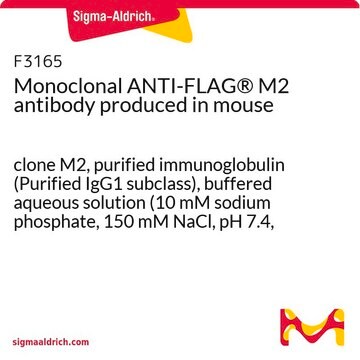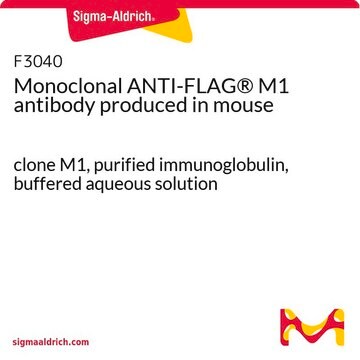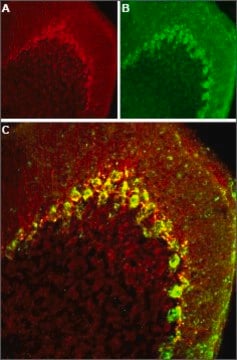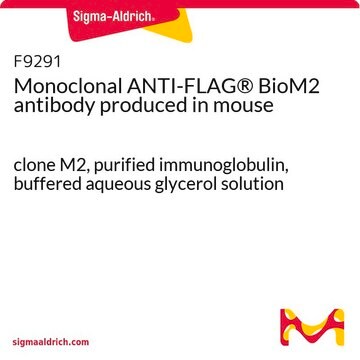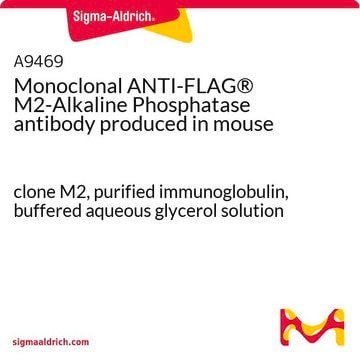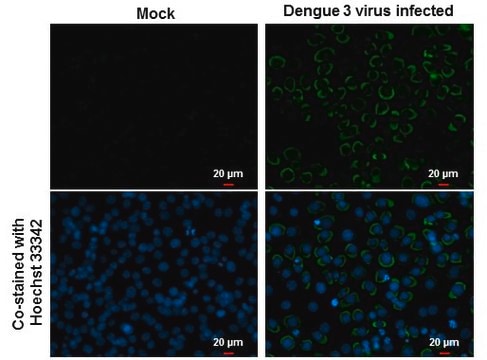SAB4200071
ANTI-FLAG® antibody, Rat monoclonal
clone 6F7, purified from hybridoma cell culture
Sinônimo(s):
Anti-ddddk, Anti-dykddddk
Selecione um tamanho
R$ 2.842,00
Selecione um tamanho
About This Item
R$ 2.842,00
Produtos recomendados
fonte biológica
rat
conjugado
unconjugated
forma do anticorpo
purified from hybridoma cell culture
purified immunoglobulin
tipo de produto de anticorpo
primary antibodies
clone
6F7, monoclonal
Formulário
buffered aqueous solution
reatividade de espécies
all
técnica(s)
immunoprecipitation (IP): 2.5-5.0 μg using lysates of transiently transfected cells expressing C-terminal-FLAG-tagged protein
western blot: 0.5-1.0 μg/mL using extracts of transiently transfected cells expressing C-terminal-FLAG-tagged protein
Isotipo
IgG1
sequência de imunogênio
(DYKDDDDK)
Condições de expedição
dry ice
temperatura de armazenamento
−20°C
Descrição geral
Monoclonal Anti-FLAG® recognizes N-terminal,
C-terminal and internal Flag-tagged fusion proteins. The product is especially recommended for identifying C-terminal FLAG®-tagged fusion proteins.
Epitope tags provide a method to localize gene products in a variety of cell types, study the topology of proteins and protein complexes, identify associated proteins, and characterize newly identified, low abundance, or poorly immunogenic proteins when protein specific antibodies are not available. Tagging with the FLAG® peptide sequence may be done at the N-terminus, N-terminus preceded by a methionine residue, C-terminus, or at internal positions of the target protein. FLAG may also be placed in associationith other tags.[1] The small size of the FLAG® tag or sequence and its high hydrophilicity tend to decrease the possibility of interference with the protein expression, proteolytic maturation, antigenicity, and function.
The N-terminal FLAG® peptide sequence contains a unique enterokinase cleavage site allowing it to be completely removed from the purified fusion proteins. Cleavage of the C-terminal FLAG® peptide from a fusion protein catalyzed by Cu2+ ions has been reported.[2] A sequence motif with five out of eight amino acid residues identical to the FLAG peptide is found in both rat and mouse Mg2+dependent protein b-phosphatase[3], as well as in the human and bovine enzyme.
Imunogênio
DYKDDDDK
Aplicação
- chromatin immunoprecipitation (ChIP)[4]
- western blotting[5]
- coimmunoprecipitation[6][7]
- flow cytometric analysis[7]
forma física
Informações legais
Não está encontrando o produto certo?
Experimente o nosso Ferramenta de seleção de produtos.
Código de classe de armazenamento
10 - Combustible liquids
Ponto de fulgor (°F)
Not applicable
Ponto de fulgor (°C)
Not applicable
Escolha uma das versões mais recentes:
Certificados de análise (COA)
Não está vendo a versão correta?
Se precisar de uma versão específica, você pode procurar um certificado específico pelo número do lote ou da remessa.
Já possui este produto?
Encontre a documentação dos produtos que você adquiriu recentemente na biblioteca de documentos.
Os clientes também visualizaram
Active Filters
Nossa equipe de cientistas tem experiência em todas as áreas de pesquisa, incluindo Life Sciences, ciência de materiais, síntese química, cromatografia, química analítica e muitas outras.
Entre em contato com a assistência técnica